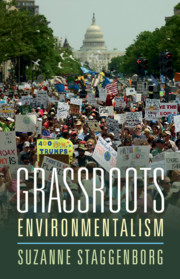Book contents
- Grassroots Environmentalism
- Cambridge Studies in Contentious Politics
- Grassroots Environmentalism
- Copyright page
- Dedication
- Contents
- Figures
- Tables
- Acknowledgments
- Abbreviations and Acronyms
- 1 Introduction
- 2 Organization and Strategy in Social Movements
- 3 Grassroots Environmentalism in Pittsburgh
- 4 Environmental Issues and Framing Work
- 5 Mobilizing a Grassroots Environmental Movement
- 6 Creating Movement Infrastructure and Community
- 7 Social Movement Meetings
- 8 Devising Strategy
- 9 Conclusion
- Fieldwork Appendix Studying Movement Dynamics
- References
- Index
- Series page
9 - Conclusion
Published online by Cambridge University Press: 21 October 2020
- Grassroots Environmentalism
- Cambridge Studies in Contentious Politics
- Grassroots Environmentalism
- Copyright page
- Dedication
- Contents
- Figures
- Tables
- Acknowledgments
- Abbreviations and Acronyms
- 1 Introduction
- 2 Organization and Strategy in Social Movements
- 3 Grassroots Environmentalism in Pittsburgh
- 4 Environmental Issues and Framing Work
- 5 Mobilizing a Grassroots Environmental Movement
- 6 Creating Movement Infrastructure and Community
- 7 Social Movement Meetings
- 8 Devising Strategy
- 9 Conclusion
- Fieldwork Appendix Studying Movement Dynamics
- References
- Index
- Series page
Summary
Grassroots activism is essential to the contemporary environmental movement. The danger to our planet from climate change is urgent and overwhelming, and related threats to water, air, land, endangered species, and human health are immense. In a situation of “all hands on deck,” local activists as well as state, national, and international organizations have much to contribute. Case studies of local movements reveal that grassroots environmentalists have achieved a great deal over many decades by raising public consciousness, changing popular discourse, testifying at hearings, lobbying government, and engaging in direct action (e.g., Bell 2013, 2016; Bevington 2009; Bullard 1990; Ferguson 2015; Longhurst 2010; McGurty 2007; Pellow 2014; Walsh et al. 1997). To be sure, there are limitations on the ability of movements to have an impact, and in some places, movements never organize at all to combat environmental threats (McAdam and Boudet 2012). My study of the Pittsburgh movement uses fieldwork conducted over a number of years, following several organizations to the end of their life spans, to provide a close-up look at grassroots environmental groups. This inside description reveals both the excitement and the messiness of collective action, which helps explain the limitations as well as the accomplishments of the movement. In this concluding chapter, I outline the implications of my research for the study for social movements and for movement activists and organizations seeking to create change through grassroots environmentalism.
- Type
- Chapter
- Information
- Grassroots Environmentalism , pp. 200 - 210Publisher: Cambridge University PressPrint publication year: 2020

